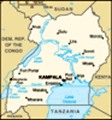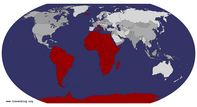Advertisement
Published: January 17th 2018
We stayed in the Rafiki Guesthouse for three nights, Jan. 10-11-12. Eleven members of our group went gorilla trekking on the 11th. Our group of seven would go on the 13th. So we had two days to ourselves to prepare for the trek and recharge our batteries. The owner of the guesthouse had a number of tours planned for us - coffee plantations and the like, however Monica and I were quite content to clean our laundry and explore the town on our own. We had lunch a couple of times at a wonderful little place called the Coffee Pot. African coffee certainly is wonderful. So dark and rich. We also had lunch at a kind of guesthouse called the Traveler's Lodge. Very nice indeed. The food was great and the history of this place says that this is where the original gorilla trackers used to stay in the sixties and early seventies - this was a second home for Dian Fossey, the woman who lived beside and eventually gave her life to save the gorillas. When Idi Amin came to power, he kicked the owners out and made the lodge a state owned facility. Today, it has regained its lustre

 One of our wonderful gorilla guides
One of our wonderful gorilla guides
this kind gent gave Monica all the assistance she neededas one of the top spots to stay in the region.
Monica and half a dozen others in the group also made a short excursion to the Democratic Republic of Congo border. It was only seven km. away to the west of Kisoro but represented a totally different culture. The DRC is a war torn, violent, corrupt country - in the far west, Kinshasa is run by a kind of African mafia; closer to us in the east, the Kivu area is largely a chaotic mess ruled over by numerous war lords. A few of the young women who accompanied Monica, wore shorts or short skirts and the local women crossing the border made comments of disapproval. A women showing too much bare skin is a cultural taboo in this region.
We were up at five in the morning getting a quick breakfast and packing up. The rest of the group would be moving on to Kabale later today so the seven of us had to pack up all of our belongings and load them onto the truck. After the trek, we would also be taken to Kabale. I should also mention that we
lost four members of our group today - Allison and Maurice, a couple from Sydney, and Dixie and her brother Deepak from London, were finished with our safari and moving on to see Africa on their own. It took us two hours to drive through the mountains along rough roads before reaching the Bwindi reserve. There are only approximately 880 mountain gorillas left in the world, living in this small mountain region where Rwanda, Uganda and Congo meet. At an altitude of around 3,500 feet, we would be trekking through dense vegetation on the volcanic slopes of the Virungas. The gorillas are herbivores, who munch the day away when they are not frolicking and sleeping. They live in family groups under the charge and protection of one dominant male. Known as the silverback, this adult male can weigh over 350 lb. There are nine families in the Bwindi region and only one group of eight people are permitted to visit each family each day. The seven of us were joined by an Irish women, Caroline. We were assigned to the Kahungye group - the name given to our gorilla family. We were given a briefing first on what to expect
and how to react. Each group had a guide, plus a leader and follower. (they referred to these two as pushers and pullers) These two also carried AK-47s with them, however, it was explained to us that the guns were loaded only with blanks that were fired to scare away the wild elephants. One of the more unique things we saw during the briefing, was a Canadian man struggling up the hill on crutches. When his group set out, he was carried into the jungle on a litter by four porters. Extra porters walked beside them as the carrying was obviously going to be rotated. It was enlightening to see how willing they were to accommodate people with disabilities.
Each family is trailed by rangers who follow the gorillas as they move each day. The rangers leave the gorillas at dusk and return to that same spot the next morning where they again will follow the gorilla's trail. Walkie-talkies are used as the rangers communicate with the guides telling them where each family can be found. After our briefing, we walked to a starting point for our group, and then waited a good hour or so for the rangers

 Our group
Our group
Back: Chris, Christine, Caroline, Marty
Front: Maddie, Royce, Laura, Monicato find our family group. When they finally did, we set out on a well worn path up into the jungle. However, after a short trek, our guide informed us that wild elephants were roaming in between us and our gorilla family. These are not the passive elephants we saw in the Serengeti - these are wild jungle elephants who are extremely dangerous. We veered off our path and started trekking through dense jungle. Our guide and leader each had a panga or scythe and we followed as they literally carved out a path for us. The frightening part was that we were heading up or down mountain slopes that were almost totally vertical. One had to walk sideways, grabbing on to every tree for support. (this was made even worse by the fact that half the trees had thorns in their bark). Both Monica and I were soaked in sweat. Even the young ones in our group were huffing and puffing. At about 11:30 - about two and half hours into our trek - we met up with the three rangers who had spotted our gorillas. We carved our way through the jungle and found the silverback sitting peacefully
enjoying a vegetative lunch. The guides and rangers used their pangas to chop away the jungle growth around the big male in order to give us a better view. We then walked along a vertical descent until we came to a tree with the mothers and two young ones sitting on the branches. It had been explained to us that these gorillas had been 'habitated'. This means that they have lost their natural fear of humans. It takes about two years of contact with rangers before the gorillas become habitated. I was amazed at either how oblivious they were to all of us, or how brave they seemed. The young frolicked in the tree putting on a show for us, while the mothers walked and crawled within only a few feet of us. We had been told not to panic if approached - just stay still and calm.
They descended the tree and virtually rolled down the hill into deeper jungle. We followed at a much slower pace. Our highlight occurred when one of the babes, about a year old, came up to where Monica was crouched and started to pull the strap on her camera case.
Monica lifted the strap off her so that the case was free and the gorilla would not accidently choke her. With the case firmly in his grasp, he ran quickly away into the jungle. The rangers followed and we watched as he played with his new toy. I had already written the case off, however, the rangers told us to be patient. Sure enough, in about 15 minutes, he discarded the case. A ranger raced in and grabbed it just ahead of one of the siblings who was obviously upset at not getting his chance to play with the new toy.
A short time later, one of the young gorillas actually came right up to one of our group and grabbed his leg. As Chris stood stalk still, it almost appeared that the young primate was kissing his thigh. The closest I came was when I was crouching at the base of their tree. A female suddenly swung onto the trunk and started to shimmy down right at me. With only a few feet to spare, she sprung off the tree and vanished down the hill.
At the end Monica and I were pretty
well spent - surviving mainly on adrenalin. One of the guides kindly helped Monica navigate the rugged terrain and I followed his path. Before saying goodbye, our guide presented each of us with a Gorilla Trekking diploma. The whole day had been an amazing experience.
We boarded our jeep - dirt, sweat and all - and drove for another couple of hours through the mountains before arriving at our campsite in Kabale, Cepha's Inn. This was actually a very classy lodge complex, with a swimming pool and two bars - one indoor and one out. But we all decided to 'tent it' instead of paying extra for an upgrade. After the jungle and the gorillas, our little tent suddenly felt very safe and secure.
FYI-FMI- Equipment needed to trek the gorillas. Good hikers and socks thick and long enough to tuck the flaps of your pants into. There are a lot of insects in the jungle and many of them one would not want to crawl up your leg!!! Long sleeve shirt for bug and scrape protection as you grasp the trees for balance. This is also why it proved helpful to wear gloves
- biking gloves and the like. The bark is very rough and thorny. A hat for sun and bug protection and a headband or bandanna - it is very humid in the jungle and one does not want the salty sweat running into your eyes. There is just too much to wonder to see.
Advertisement
Tot: 0.135s; Tpl: 0.018s; cc: 13; qc: 51; dbt: 0.0538s; 1; m:domysql w:travelblog (10.17.0.13); sld: 1;
; mem: 1.2mb






















Heather and Norm
non-member comment
only one word
WOW!!!!!!